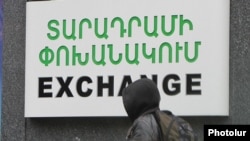The Central Bank of Armenia (CBA) has stepped up its hard currency interventions in an apparent effort to prevent a renewed depreciation of the national currency, the dram, as a result of downward pressures from Russia.
The CBA injected $50 million in the local currency market on Wednesday, a sharp increase from the usual volume of its interventions rarely exceeding several million dollars a day.
The move followed a roughly 1.4 percent weakening of the dram against the U.S. dollar registered since last weekend. The dollar-dram exchange rate had barely changed since the beginning of this year.
The CBA did not give any reasons for what was a massive dollar injection by Armenian market standards. Analysts believe that the move was designed to shore up the dram amid a further depreciation of the Russian ruble resulting from a continuing decline in international oil prices.
The ruble has fallen by around 13 percent against the dollar since the beginning of July. The Russian currency has lost roughly half of its value against the dollar and the euro over the past year.
The ruble’s depreciation has significantly cut the dollar-denominated value of vital remittances sent home by hundreds of thousands of Armenians working in Russia. Consequently, the dram came under strong downward pressures late last year, weakening against the dollar by around 17 percent in October-December.
Exchange rate fluctuations in Armenia were particularly sharp in mid-December, causing panic buying of dollars and briefly disrupting retail trade. The CBA managed to stabilize the currency market by sharply raising interest rates, tightening minimum reserve requirements for Armenian commercial banks and cracking down on what it called speculative currency trading. The dram depreciated by only 1.6 percent from January through the end of last week.
Bagrat Asatrian, a former CBA governor critical of the Armenian authorities, on Thursday criticized the latest Central Bank intervention, saying that the dram’s exchange rate is “artificial” and that the authorities want to keep it unchanged for political reasons. In particular, he pointed to a constitutional referendum which President Serzh Sarkisian plans to hold in November.
“Over the past year, the most stable currency [in the non-Baltic former Soviet Union] has been the Armenian dram,” Asatrian told RFE/RL’s Armenian service (Azatutyun.am). “This should not have been the case because the Armenian economy is definitely not the most stable among these countries.”
Asatrian also claimed that the authorities risk further depleting Armenia’s modest foreign exchange reserves. “If this is a continuous policy, if the Central Bank wants to set a particular exchange rate, then that runs counter to both the bank’s obligations and the interests of our economy,” he said.




